










AREA #1 - Out-of-State, Panhandle
Brandon St. John (912) 674-6127 ktm21brandon@yahoo.com
AREA #2 - Hamilton, Suwannee, Columbia, Baker, Union, Bradford, Nassau, Duval, Clay, Putnam, St. Johns
James Benton (904) 589-0093 bentonracing116@yahoo. com
AREA #3 - Gilchrist, Alachua, Levy, Marion, Citrus, Sumter, Lake
Allen Pearce (352) 339-5644 Allen.Pearce17@gmail.com
AREA #4 - Flagler, Volusia
Mike McGuire (386) 871-0666 makmcguire@yahoo.com
AREA #5 - Hernando, Pasco, Pinellas
Dale Ellis (407) 467-1196 dellis117ktm@gmail.com
AREA #6 - Hillsborough, Polk
West Anderson (863) 604-1868 jetster220@gmail.com
AREA #7 - Seminola, Osceola, Orange
Will Busick (317) 507-6636 willb763@gmail.com
AREA #8 - Brevard, Indian River
John Happel (321) 759-1454 keepyourjoy@yahoo.com
AREA #9 - Manatee, Sarasota, Hardee, DeSoto, Highlands
Brian Dugre (941) 893-7898 brian@mycentec.com
AREA #10 - Okeechobee, St. Lucie, Martin
George Pollard (772) 349-6534 ktmgeorge811b@gmail.com
AREA #11 - Charlotte, Lee, Glades, Hendry, Collier
Ken Redford (239) 297-7170 redford_kenny@yahoo.com
AREA #12 - Palm Beach
Austin McAfee (561) 337-0998 amcafee379@aol.com
AREA #13 - Borward, Dade, Monroe
Max Rash (954) 609-1812 maxr@rivaracing.com
Apollo M/C
Mark Bordelon (321) 794-0993 markbord115@gmail.com
Big O Trail Riders
Tommy Clay (863) 532-1952 tommy_clay@yahoo.com
Big Scrub Trail Riders
Curtis Bell (386) 679-8201 curtbell@rocketmail.com
Central Florida Trail Riders
AJ Stagg ajstagg@gmail.com (407) 929-2114
Columbia Enduro Riders
Ricky Dennis (803) 786-0051 mastercraft@bellsoth.net
Daytona Dirt Riders
Joe Carrasquillo (386) 615-0722 secretary4ddr@gmail.com
Family Riders, Inc.
Johnny Thomas (843) 553-1463 familyriderssc@bellsouth.net
Greenville Enduro Riders
Chris Poole (864) 617-4342 info@greenvilleenduroriders. com
Nature Coast Trail Blazers
Rob Swann (813) 731-5552 naturecoasttrailriders@gmail. com
Old School Dirt Riders
Ben Kelly (941) 650-1473 ftr90racer@yahoo.com
Palm Beach Track & Trail

Randy Rash (954) 931-5709 motodadfla19@aol.com
Perry Mountain M/C
Brad Belcher (205) 340-4298 perrymountainmotorcycleclub@gmail.com
River City Dirt Riders
James Benton (904) 589-0093 bentonracing116@yahoo. com
Sarasota Area Dirt Riders
Randy Faul (863) 244-3709 randt817@gmail.com
Southeast Florida Trail Riders
Frank Campbell (561) 951-3732 flawoods35@yahoo.com
Sumter Enduro Riders
Johnny McCoy (803) 481-5169 serma@ftc-i.net
Suncoast Trail Blazers
Cary Hunt 727-635-6228 suncoastbiz1@gmail.com
Sunrunners Dirt Riders
West Anderson (863) 604-1868 jetster220@gmail.com
Tallahassee Trail Riders
Mikey Rainey (350) 591-5386 trailriderstallahassee@gmail. com
Treasure Coast Trail Riders
Ken Harris (772) 370-4434 khei9862@gmail.com

AA/A ENDURO
Mark Mannschreck (813) 310-2067 hondamm61@aol.com
B/C ENDURO
Sam Boydstun (407) 467-3951 woodsracercfl@rr.com
SPECIALTY A/B ENDURO
Ronnie Hames (386) 547-2397 ronnie@hbdmotografx.com
SPECIALTY C/WOMEN ENDURO
Elesa Berard (407) 376-7115
AA/A HARE SCRAMBLE
Troy Gardner (561) 329-7866 troyracing41@gmail.com
B/C HARE SCRAMBLE VACANT
SPECIALTY A/B HARE SCRAMBLE
Paul Lucas (305) 244-7531 happytimesamuse@msn.com
SPECIALTY C/WOMEN HARE SCRAMBLE
Holly Langford (954) 504-2659 hollylangford10@gmail.com
SATURDAY CLASSES HARE SCRAMBLE
Derek Tremain (863) 634-8183 derektremain@gmail.com
QUADS
Pete Rose (941) 270-1189 pwrracingktm@gmail.com
PRESIDENT
Randy Faul (863) 244-3709 president@floridatrailriders.org
VICE PRESIDENT
Pete Rose (941) 270-1189 vicepresident@floridatrailriders.org
SECRETARY
Bill Toreki 352-372-1135 secretary@floridatrailriders.org
TREASURER
Kayla Vawter (863) 381-2649 treasurer@foridatrailriders.org
HARE SCRAMBLE CHAIRMAN
Randy Rash (954) 931-5709 hschair@floridatrailriders.org
ENDURO CHAIRMAN
George Tolson (863) 698-3837 gjtolson63@gotmail.com
HARE SCRAMBLE REFEREE
Jeff Hazeltine 941-468-7204 hsref@floridatrailriders.org
ENDURO REFEREE
Peter Magee (352) 262-4974 cr250m@bellsouth.net
BUSINESS MANAGER
Darlene Riggs (352) 538-6291 businessmanager@floridatrailriders.org
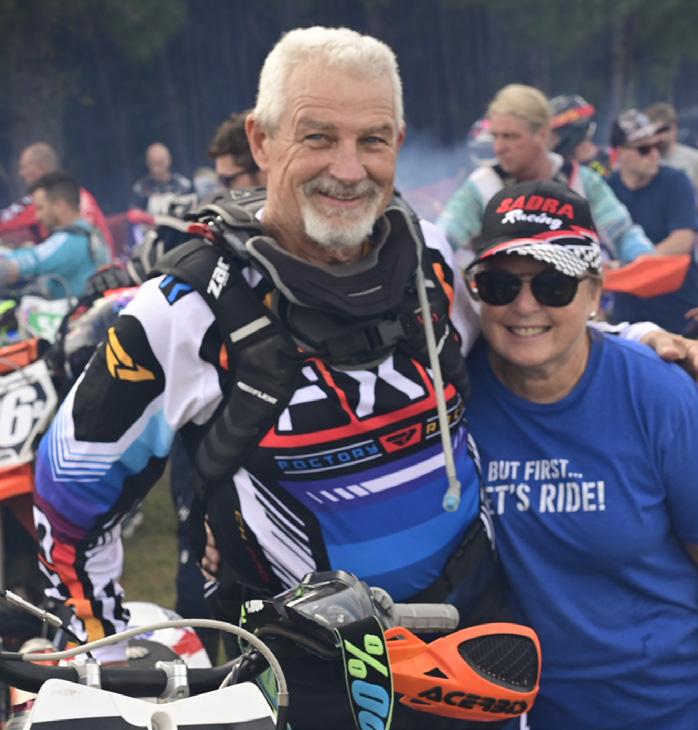
As I reflect back on the Dec 7,8 event at the Bartow property, I don’t think I can remember an event where there was so much going on. While the prep prior to the event was off the chart with the hurricane, rescheduling, cleaning the property up from fallen trees, debris and getting over 3 miles of new virgin woods around the biggest lake on the property taken away from us, needless to say we had to dig deep on this one. Race weekend arrives and it seems like we are back to some kind of normalcy only to be interrupted by a fire on Saturday which added to an “All hands-on Deck” situation. Thanks to all the members that jumped in and helped it was contained with the use of a skid steer and extinguishers. As that was an eye opener, plans are in the works now to have a mobile unit with a motorized water tank and sprayer for future events that should be at the events by the time you read this.
I had the chance to ride an enduro early this
season as we made the trip up to the RCDR St. Mary's Shoals event back in November and it was an eye opener as it’s been so long since I rode one. The trip up and back was a hoot as shenanigans could happen at any time with my partner in crime. The course was the real deal, even my AA sidekick looked a little beat at the end of the day. River City Dirt Riders did an outstanding job in laying this out and had all the bases covered for a successful weekend. As some of you may not know, back in the 70’s when FTR was formed, the group started out promoting enduros and as the organization grew, the mid 80’s brought the HS series.
I remember riding the Alligator back when we started out at the back of the speedway on a wooden built podium and rode off on your minute and actually down the highway to the woods. DDR was and still is the promoting club as they had a huge circus tent that displayed the results and the crowd had some very big names in the offroad world where they
came from all over the United States. Time keeping was a wrist watch and odometer back then, but soon went to bar mounted computer type time keepers as we had mud, water and palmetto roots the size of your leg. If you ever wanted to try one, the system now has moved to the sprint format where there’s no time keeping so it's just riding as fast as you can from checkpoint to checkpoint. We have several in-state enduros that are coming up in Feb. and March being the Straight Arrow and the Alligator along with the Armadillo later in April, give one a try as you will definitely get enough riding time.
As we move into a new year and the second half of the season, I would like to thank everyone that participated in our elections and supported me for another two years. I am humbled and appreciative of your support.
See you at the starting line or on your minute at an enduro.
Thanks for listening Randy Faul
Starting Line to Checkered Flag…
“I have fought the good fight, I have finished the race, I have kept the faith.” 2 Timothy 4:7
As we just finished the holiday season, I was reflecting on the last words of the Christmas carol, “ Silent Night”. The author asked the Christ child and the world to “sleep in Heavenly peace.”
We are starting a new year. We are also starting the heaviest part
Desde la línea de salida a la bandera de cuadros...
"He peleado la buena batalla, he terminado la carrera, he mantenido la fe". 2 Timoteo 4:7
Según nos acercamos al final de la temporada navideña, estaba reflexionando sobre las últimas palabras del villancico, “Noche de Paz”. El autor pidió al niño Jesús y al mundo que “duerman en la paz celestial”.
Estamos comenzando
of the FTR season with events almost every two weeks. With all the pressures in our lives on a daily basis, peace is something we long for but cannot find.
Jesus, on the evening before his death on the cross, gave his disciples a wonderful gift; a gift available to all who believe in Him. In John 14:27 Jesus said, “Peace I leave with you; my peace I give you. I do not give to you as the world gives. Do not let your hearts be troubled and do not be afraid.”
un nuevo año. También estamos comenzando la parte más intensa de la temporada FTR con eventos casi cada dos semanas. Con todas las presiones en nuestras vidas a diario, la paz es algo que anhelamos, pero no podemos encontrar.
Jesús, la víspera de su muerte en la cruz, hizo a sus discípulos un regalo maravilloso; un regalo disponible para todos los que creen en Él. En Juan 14:27 Jesús dijo: “La paz os dejo; mi paz te doy. No os doy
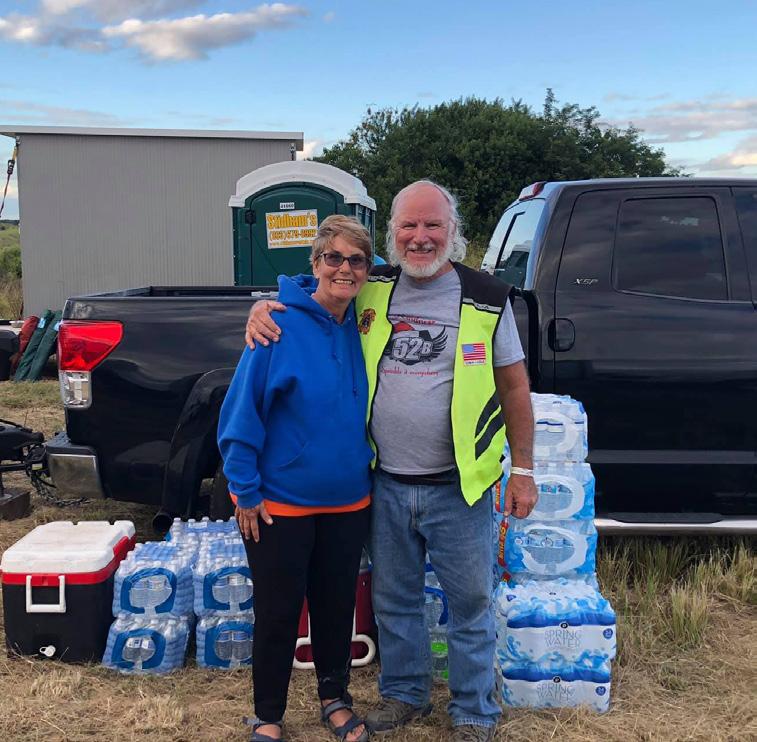
That gift of peace comes from His Spirit, The Holy Spirit, indwelling in our hearts and lives. Jesus also said in John 16:33, “I have told you these things, so that in me you may have peace. In this world you will have trouble. But take heart! I have overcome the world.”
What a wonderful promise! He loves us so much and just wants us restored to Him by believing in Him. “And the peace of God, which
como el mundo da. No se turbe vuestro corazón ni temáis”.
Ese don de paz proviene de Su Espíritu, el Espíritu Santo, que habita en nuestros corazones y vidas. Jesús también dijo en Juan 16:33: “Os he dicho estas cosas para que en mí tengáis paz. En este mundo tendrás problemas. ¡Pero anímate! Yo he vencido al mundo”.
¡Qué maravillosa promesa! Él nos ama mucho y sólo quiere que seamos restaurados a
transcends all understanding, will guard your hearts and your minds in Christ Jesus.” Philippians 4:7.
Have a very blessed, safe, and most of all peaceful New Year!
Blessings on and off the road,
Jim and Betty Edleston Chaplain FTR
Él al creer en Él. “Y la paz de Dios, que sobrepasa todo entendimiento, guardará vuestros corazones y vuestros pensamientos en Cristo Jesús”. Filipenses 4:7.
¡Que tengas un Año Nuevo muy bendecido, seguro y, sobre todo, en paz!
Bendiciones desde la carretera y el monte, Jim y Betty Edleston, Capellán de FTR

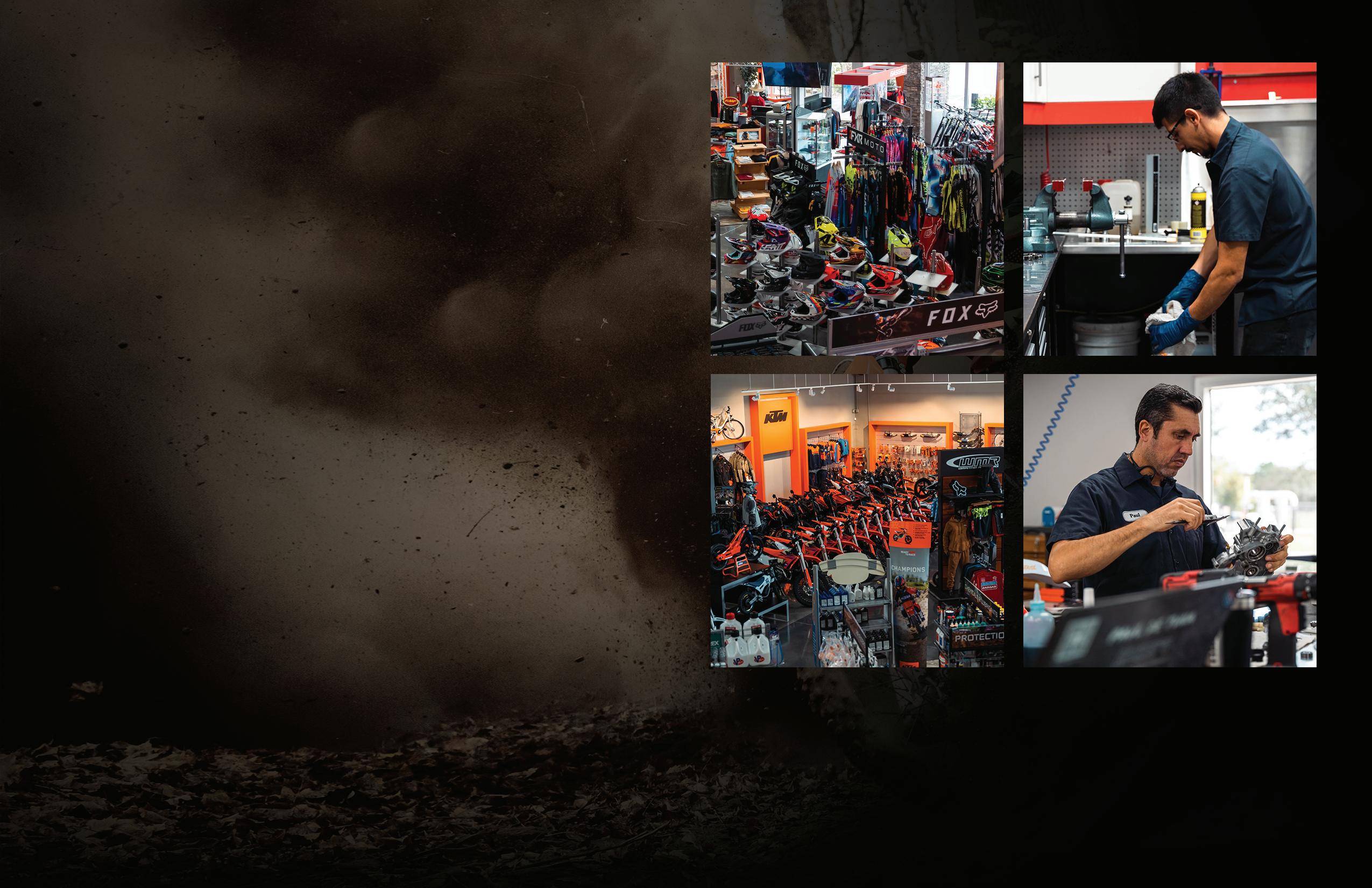
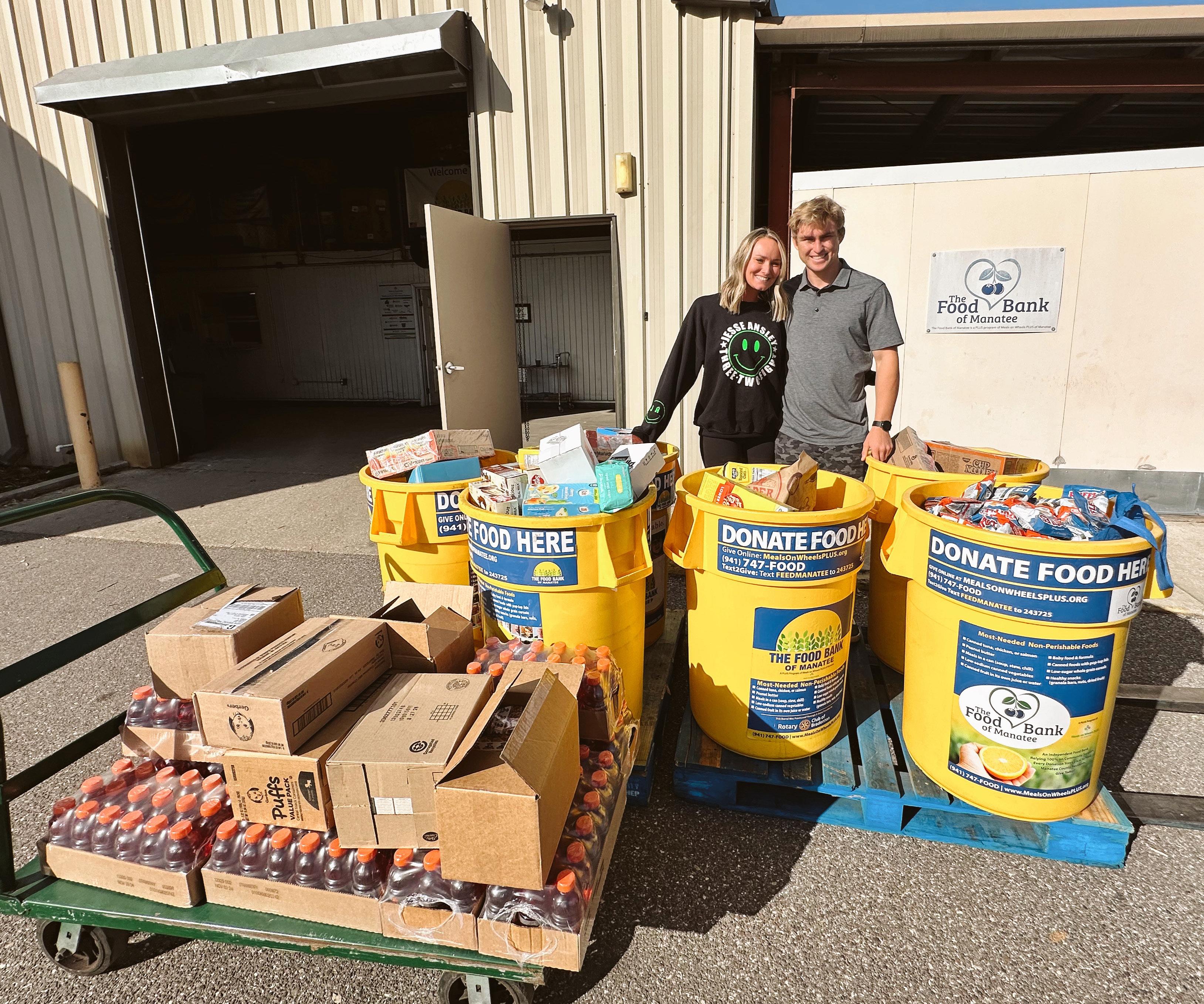
A heartfelt thank you to the incredible members of FTR for their generous support of Jesse Ansley and the Manatee County Food Bank at the SADRA Harescramble. With your help, we not only met our goal of filling 6 yellow food bins, but we exceeded it, raising an impressive 932 lbs of non-perishable food, feminine products, hygiene items, and more. This was especially meaningful after the community was impacted by three major hurricanes earlier this summer, leaving the food bank in urgent need of restocking for the holiday season. We couldn't have done it without your dedication and support, and we're excited to aim even higher for our next food drive in the Summer of 2025!
-Team JA328

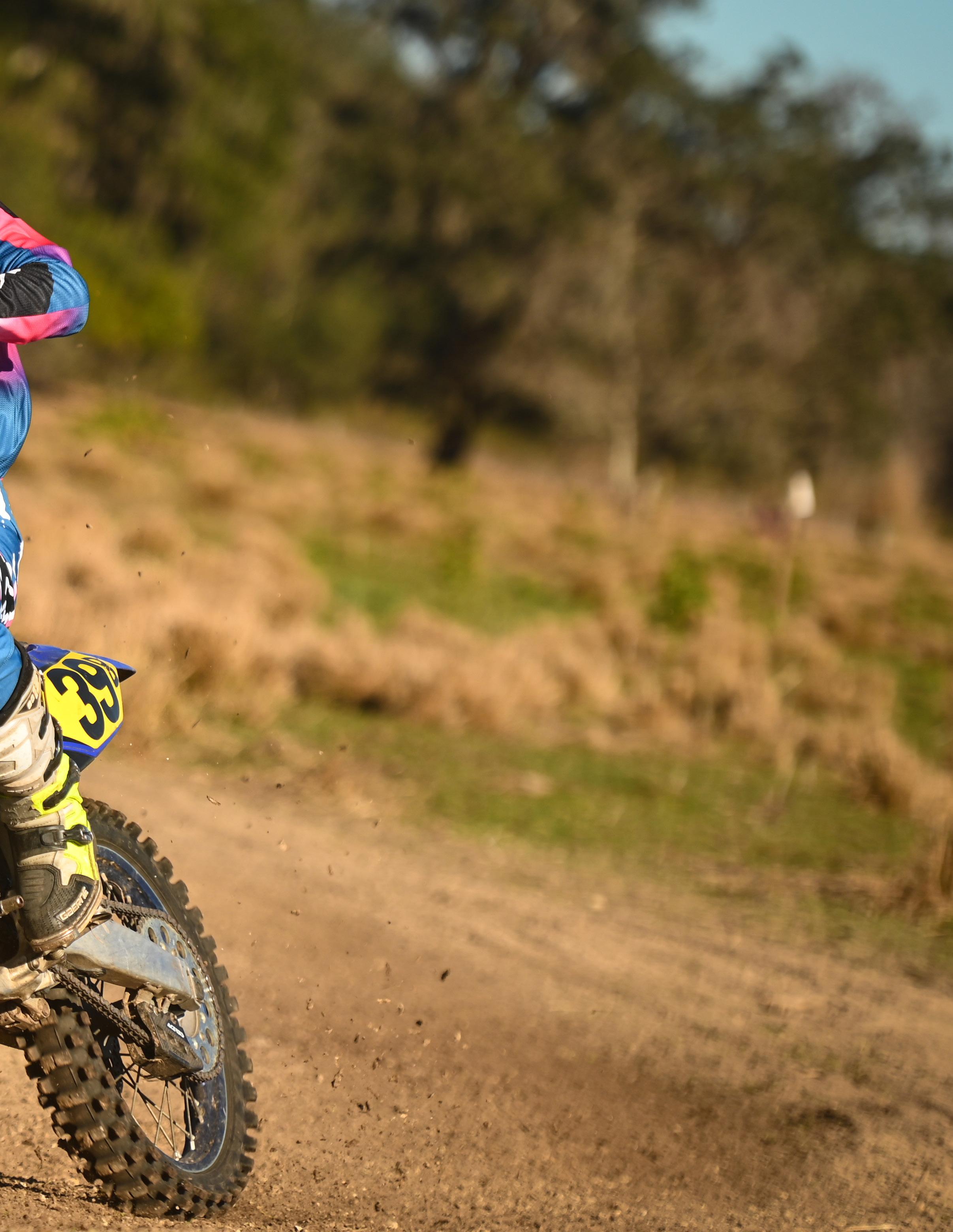
Photos: Brianna Avirett




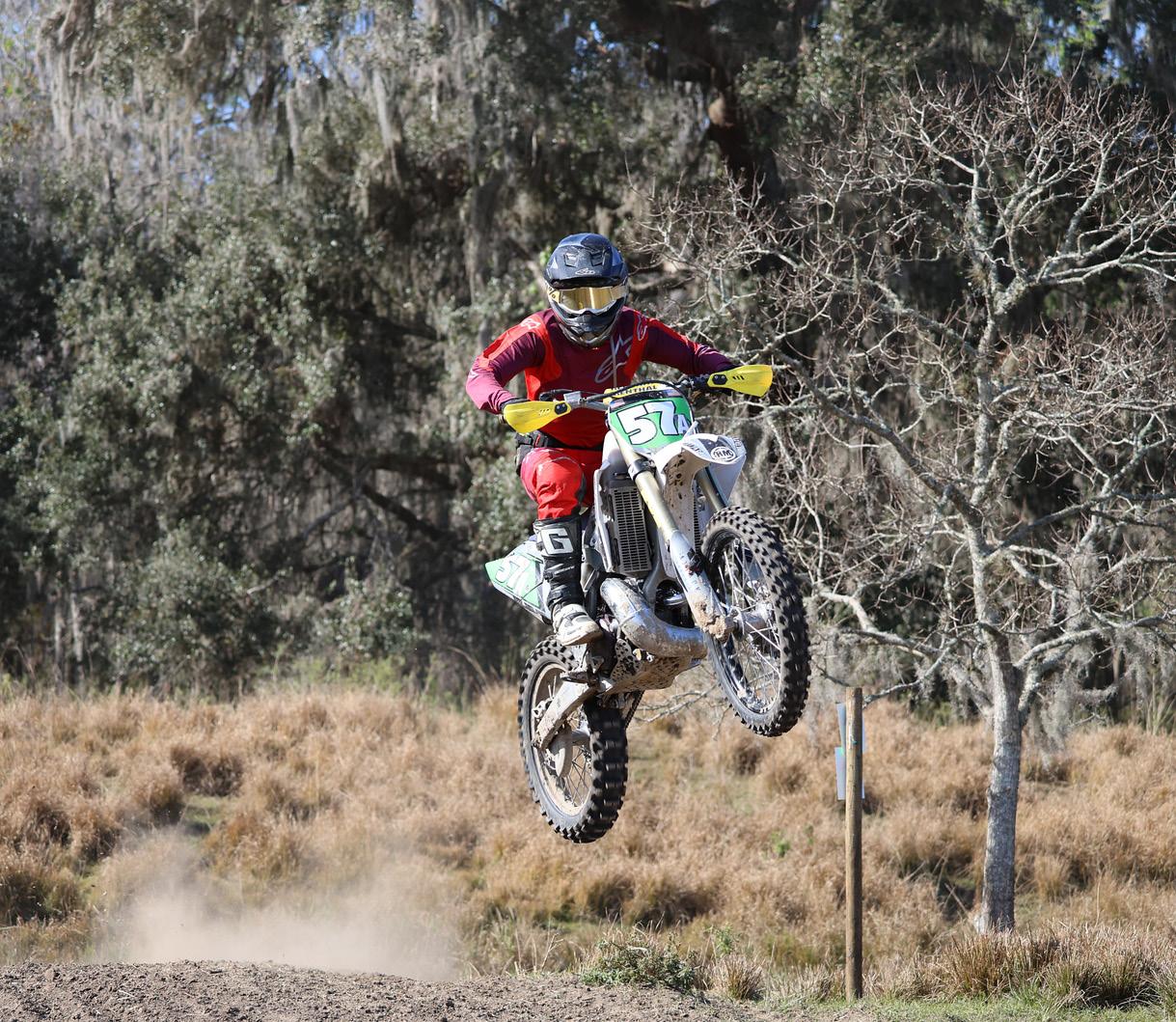

“Wat’ u talkin’ ‘bout, willis?”
The safety team constantly reminds us to “hydrate”. But what do those guys in the orange shirts and blue asterisks really mean? Here are a few quick thoughts on race hydration.
A few years ago, I was a team physician for the International Six Days Enduro. It was a rocky, sunny, hot, and dry torture test. From a medical perspective, our biggest problem wasn’t crash injuries, it was dehydration. Even our best riders came into the medical tent for IV fluid replacement at the end of the day. The first couple days were the roughest…until we convinced them that they had to up their hydration while riding.
Water makes up 60% of our body mass (Thank you Ken Jennings). When we exercise, we lose some of that water through sweating and breathing. The harder we exercise, the more sweating we do and the harder we breathe. Our respirations carry fluid/moisture out of the body (think about the cold winter mornings… and the moisture we see condensing as we exhale). When we lose fluid, we lose body function and efficiency.
Fluid replacement is critical because the fluid in our blood vessels carries
nutrients, including oxygen, into the cells, plays a major role in thermoregulation (body temperature control), and removes the waste products of energy metabolism. Loss of body fluid leads to loss of delivery of energy, impairs thermoregulation, leads to a loss of optimal muscle function, and impairs removal of cell energy waste products.
Here comes some “nerdy” stuff…
Sweat glands help with thermoregulation by secreting fluid due to an increase in skin and body temperature. Heat acclimation and aerobic training can increase the response to an increased body temperature with an earlier onset of sweating and greater responsiveness to temperature increase. Dehydration/ hypovolemia will delay or obtund the sweat response.
Sweat is primarily composed of water and salt: Sodium (10-90 mmol/L— Yeah, I know, worthless medical gobbledygook), and chloride (in about the same amount as sodium—10-90 millimoles/ liter). Potassium is also secreted (2-8 millimoles/ liter) but at a significantly lower rate than sodium and chloride. Other trace components of sweat are vitamins, minerals, calcium, magnesium, and iron in minimal quantities. Volumes of up to ½
gallon of water, salt, and electrolytes can be lost in an hour during heavy exertion.
The bottom line? (Sorry, not yet)
Having said all that, it is advisable to ensure you are not hypovolemic (again, low on fluids, dehydrated, or “not tanked up”,) when you hear “10 seconds”. Hydration (to achieve a euvolemic or net zero fluid balance) can be started over a few days, or even one day, prior to a race. It is best to consume an increased fluid intake over time rather than attempting to down a gallon of water on the way to the race. Ingestion of large quantities of fluid over a short time increases the intravascular volume quickly and then it gets excreted by the kidneys before optimal tissue balance can be accomplished.
Can we store it up? Dream on, sweat sweet pea
Can you pre-overhydrate...” stock up”? In general, the short answer is, no. But pre-race hydration can ensure your “tank” is full.
Why can’t you overhydrate? Think of fluid balance like your gas tank: you’ve run 4 of SADRA’s 15-mile loops and your gas tank contains only fumes(hypovolemia). You pull into the pits to fill
up. You can fill your tank until it is full(euvolemia). Once your tank is full it will start to run out the opening. Overfilling is hypervolemia. Like your tank overflowing, your kidneys dump the excess hydration.
Body fluid control is managed primarily by the kidneys. For most FTR members, who are typically healthy, with normal functioning kidneys, drinking lots of fluid will lead to lots of…urinating. On the other hand, if you are hypovolemic (low on body fluid or dehydrated) then you are not gonna’ pee very often or very much. You can get “tanked up” by drinking the deficit in fluid. This brings you up to “euvolemia” or a zero fluid balance. Once you over hydrate, the kidneys work to bring the body fluid volume back into balance and you “gotta’ pee”. This eliminates excess fluid (hypervolemia).
Bottom line? We’re getting there…
So, how do we “hydrate”?
There are lots of hydration plans available on the interweb (floating around up there in space somewhere) and everyone has their own idea of the perfect plan. Consider the following general principle: 1.) Hydrate, 2.) follow your hydration state by watching the color of your urine and the quantity of
output, and 3.) replenish according to actual fluid loss. So, what does that look like on a practical basis?
4 hours prior to activity consume 17-20 oz or 1 ounce/12.5 pounds body weight (or just drink a bottle of Gatorade/Powerade)
Within about 45-90 minutes you should start to urinate (pee). The color will give you some indication of where you are… dark urine (or a quantity of just a few drops) means you are behind in fluids…light color or clear urine means you’re in good shape. If you pee large volumes of clear stuff, you are probably good to go.
As an aside, urine color is a “general” indication of fluid status. Dark urine indicates that the products of energy metabolism are very concentrated and need more fluid to help wash them out. If the urine is colorless then you are probably adequately hydrated. One caveat, if your diet consists of elements that alter the color of your urine then “color” will be a less reliable indicator.
2 hours prior to activity, assess the urine output and color. If the urine is dark (or you haven’t pee’d yet) consume 3-5 cc/kg or 7-12 ounces over 20 minutes or so. (Just drink another bottle of sports drink). Re-assess urine color and output in an hour.
During the event, it's critical to replace the compo-
nents of sweat (and losses from breathing) with water and salt. Quantities of fluid replacement may vary between 6-12 ounces or more every 15 minutes. Activities over an hour long may benefit from the addition of carbohydrates. (Powerade contains high fructose corn syrup and Gatorade packs sucrose and dextrose).
And now a word from our sponsor…water.
Hypotonic replacement fluids lack the elements that we sweat. The most common hypotonic fluid is water. Isotonic fluid has the same balance of carbs/electrolytes as blood. Hypertonic fluids have more carbs/electrolytes.
Water is great at hydration and works very well for pre-race hydration and getting “tanked up” BUT keep in mind that massive quantities of water in the face of massive perspiratory (lots of salt loss) and respiratory losses during an event CAN lead to hyponatremia (low blood sodium levels).
During an event, it is optimal to replace the electrolytes lost in sweat. Hyponatremia is a really bad thing. It can lead to seizures, brain swelling, and other things that may cause you to miss the next race. The risk of experiencing hyponatremia is probably very low but so is the risk of many things we have seen this season. In general, drinking a couple bottles of the water that Big Jim and CMA hand out at the finish line won’t lead to significant
hyponatremia but if you are tanking a couple liters at a time you could be heading that way.
Sports drinks…the never-ending discussion. Sports drinks are sold as rapid replacement fluids for active athletes. They tend to be hypertonic and aim to replace the major components of sweat (water and salt). Some drinks add micronutrients and vitamins.
Are expensive drinks worth the cost? What pre-mix should I use? Is a $600 helmet worth the cost?....everybody has an opinion. My own opinion…not that anybody selling AdvoCare or LiquidIV would agree…is that a good old fashion Powerade/Gatorade product is a reasonable replacement fluid, is readily available, and costs less than other “super drinks”. They both contain salt along with a carbohydrate. But, my opinion is worth only what you paid for it…
Signs of dehydration include dry mouth, cracked lips, decreased urine output, dark urine, irritability (not because Barry McCarty lapped you twice during your race), muscle cramping, confusion, headache, and, with major-dude dehydration, dry skin. Extreme dehydration leads us to the final point: heat exhaustion and heat stroke.
The end point to be avoided: Heat exhaustion vs. heat stroke
Heat exhaustion: Body
temperature remains below 104 degrees with signs of dizziness, nausea, weakness, headache, muscle cramps, fatigue, rapid weak pulse
Heat stroke: The body has lost control because it is dried out. There are no fluids to be “sweated”, the body overheats, and body temperature rises to life-threatening levels above 104 degrees. Signs are hot red DRY skin accompanied by confusion, agitation, aggression, hallucinations, slurred speech, fainting, and a loss of consciousness.
Hydration…now you know the rest of the story.
I’ve covered a lot of ground here…discussed why it’s important, suggested a plan, and noted some things to watch out for. Please think seriously about your plan before it’s too late.
From the medical team… be safe. As always, your FTR medical support team is available for questions or medical assistance.
Disclaimer: I don’t own stock in Gatorade/Powerade and only mention it as my own personal use, not as a recommendation.
Disclaimer 2: I have never been lapped twice by Barry McCarty.
best entertainment the weekend has to offer. The crowds are getting bigger and bigger with each race and the number of entries has races are put on by Maykel Penalver and first started in 2016 at the Apollo Hare Scramble in Samsula. “The first race was Striders only started growing from there,” Maykel said. Fast forward to 2024 and the races have grown exponentially with the races averaging over courses are improvised, and I have to work accordingly with the club to ensure the courses are safe for the little ones,” Maykel said. on the course once it is up to get some practice in before the races start. Signups for the races happen next to the course prior to
If you have ever camped at an FTR hare scramble you have probably seen or heard a crowd of people screaming and yelling on Saturday nights. What you might not know is that some of the best racing is happening in the middle of that crowd. The Stacyc and Strider races are some of the best entertainment the weekend has to offer. The crowds are getting bigger and bigger with each race and the number of entries has skyrocketed.
The races are put on by Maykel Penalver and first started in 2016 at the Apollo Hare Scramble in Samsula. “The first race was Striders only and we just took some ribbons and stakes from the peewee track and after about an hour of set up we had about eight kids lined up to race and it just started growing from there,” Maykel said. Fast forward to 2025 and the races have grown exponentially with the races averaging over 40 racers in five different classes.
“The courses are improvised, and I have to work accordingly with the club to ensure the courses are safe for the little ones,” Maykel said. The courses are put together next to the peewee track and the races happen on Saturday nights at 6pm. Kids are welcome to ride their Stacycs and Striders on the course once it is up to get some practice in before the races start. Signups for the races happen next to the course prior to the event.


Photo by Garren Wright (2025)
has skyrocketed. only and we just took some ribbons and stakes from the peewee track and after about an hour of set up we had about eight kids lined over 40 racers in five different classes. The courses are put together next to the peewee track and the races happen on Saturday nights at 6pm. Kids are welcome to ride the event.
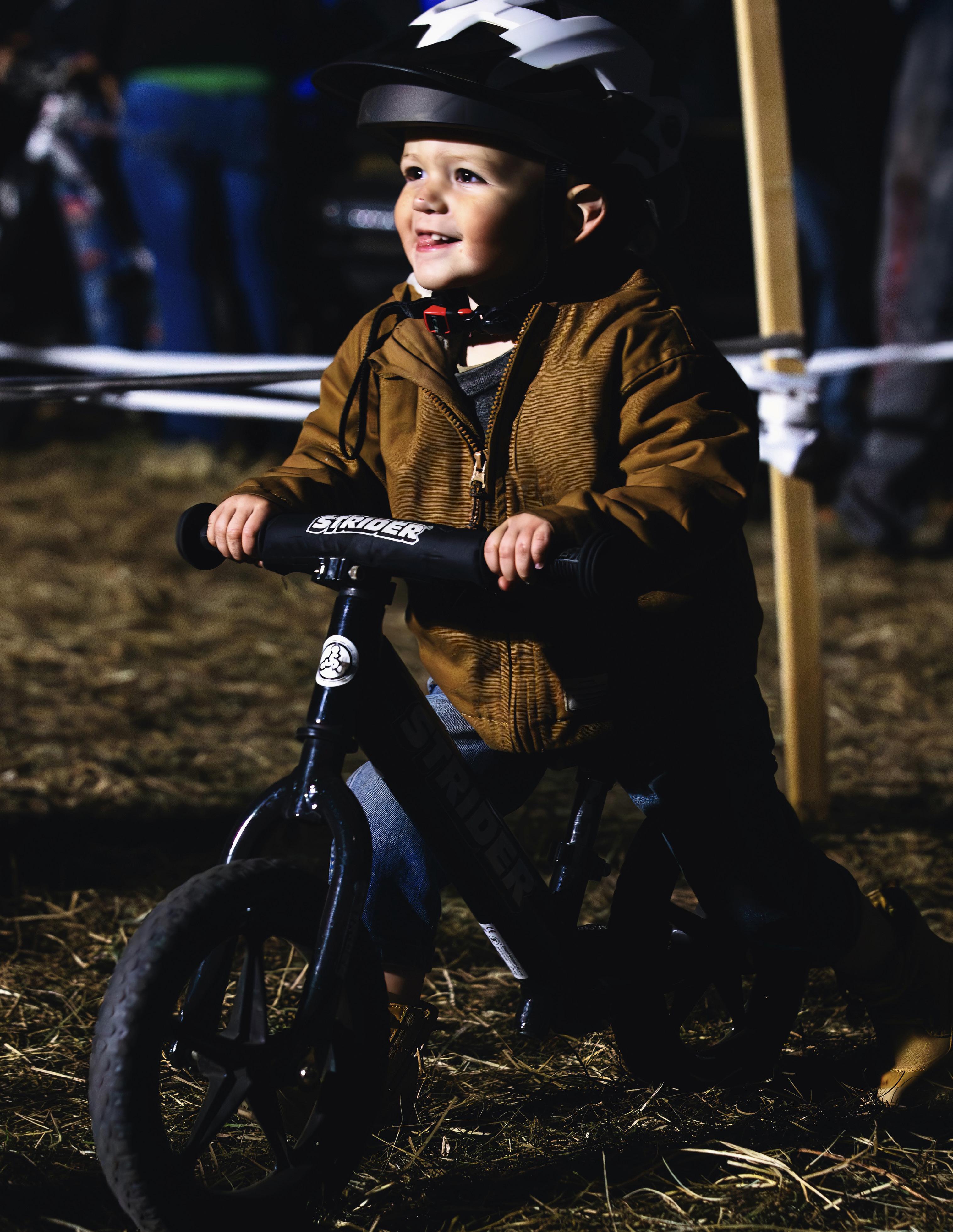
WORDS: DR. MATT DAUGHERTY
In the healthcare field there is a lot of misinformation out there. When I started this column, one of my goals was to provide accurate and useful information for the FTR community. I often run into both overused and incorrectly used diagnostic labels, which is one of my favorite things to straighten out. Recently, I ran into the often overused label of “piriformis syndrome”.
Piriformis syndrome is often misunderstood, even among athletes and those with persistent gluteal pain. Mislabeling deep buttock pain as piriformis syndrome oversimplifies a condition rooted in anatomical details. As an orthopedic physical therapist, I frequently see patients misled by this misconception. The truth is more complex and tied to anatomical intricacies.
The piriformis muscle is a small, deep muscle located in the buttock, which stabilizes the hip and allows external rotation of the femur. Its position beneath the larger gluteal muscles can make it challenging to assess and treat. However, the key feature of piriformis syndrome is gluteal pain combined with sciatic nerve involvement.
A common misconception attributes any deep, nagging buttock pain to
piriformis syndrome. In reality, gluteal pain can stem from lumbar disc issues, sacroiliac joint dysfunction, or trigger points within the gluteal muscles. Piriformis syndrome, by contrast, involves entrapment or irritation of the sciatic nerve as it passes through or around the piriformis muscle. This distinction is crucial.
In most individuals, the sciatic nerve courses beneath the piriformis. However, anatomical variations exist. The sciatic nerve may pierce through the piriformis muscle in approximately 15% of the population. This structural anomaly may predispose individuals to nerve entrapment, particularly when the piriformis becomes tight or spasms, compressing the sciatic nerve. The result is a distinct pain pattern radiating from the buttock down the posterior thigh, often mimicking sciatica. While these variations exist, not everyone with such anatomy will experience symptoms.
This nerve entrapment can lead to tingling, numbness, burning sensations along the nerve’s path, and localized

gluteal pain. In contrast, patients with gluteal discomfort but no sciatic involvement are more likely to experience muscular dysfunction, tendinopathy, or hip pathology.
Diagnosing piriformis syndrome involves differentiating it from lumbar radiculopathy or other sciatic nerve irritations. A thorough evaluation, including movement assessments, palpation, and tests like the FAIR (Flexion, Adduction, Internal Rotation) test, is crucial to pinpoint the pain source.
Treatment for true piriformis syndrome addresses both muscle and nerve. This often includes manual therapy to release piriformis tension, nerve glides to mobilize the sciatic nerve, and exercises to strengthen the hip rotators and improve pelvic stability. In resistant cases, dry needling, extracorporeal shock wave therapy, and corticosteroid injections can help.
Education plays a vital role in managing piriformis syndrome. Patients benefit from understanding their condition, dispelling myths that all buttock pain stems from the piriformis. Addressing biomechanical issues and promoting proper movement patterns can alleviate symptoms and prevent recurrence.
In conclusion, piriformis syndrome is a specific condition defined by sciatic nerve entrapment,
not generalized buttock pain. As clinicians, we must provide accurate diagnoses and individualized care, guiding patients from misconceptions and toward effective, evidence-based treatment.
Before acting on any information in this article, I recommend you consult a physical therapist or physician for a general health and physical activity readiness screening. If you are experiencing pain while riding, it is always beneficial to have a complete evaluation by a physical therapist or physician. If you have any questions or comments, please email me at contact@ motopt.com or call/text 904-395-5379. Let’s IMPROVE YOUR MOVE so you can ride pain-free with MotoPT.
Dr. Matthew Daugherty PT, DPT, OTR/L, MOT, DBA
Associate Professor and Director of Residency Programs
Board Certified Orthopaedic Clinical Specialist
Fellow, American Academy of Orthopaedic Manual Physical Therapists Manual Therapy Certified
Intramuscular Dry Needling Certified



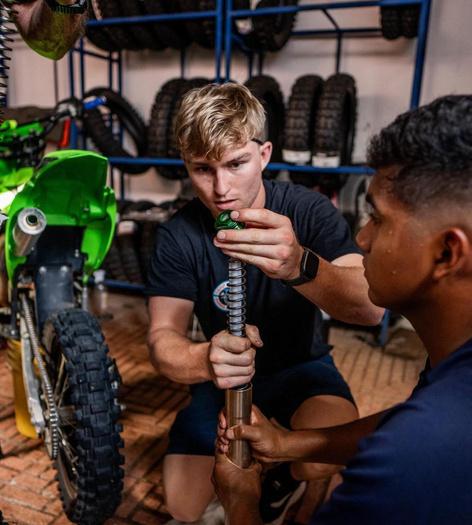




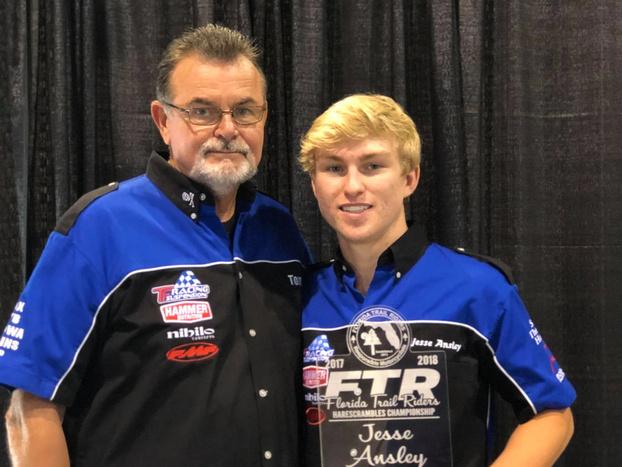
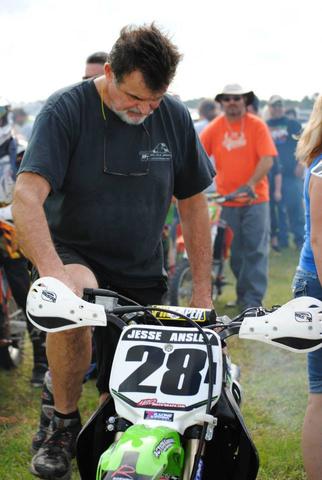




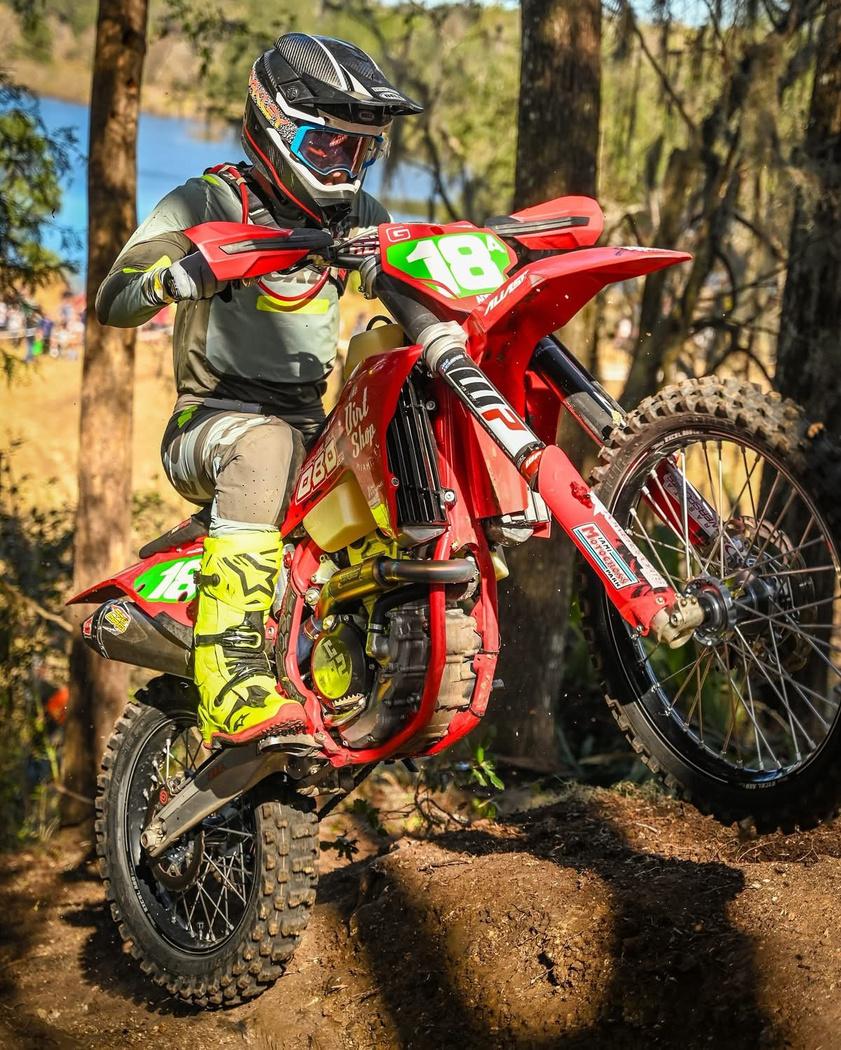


Hi everyone, hope you guys are enjoying the new year and are getting out to ride in this amazing weather! My name is Alex Lugar and this is a new column I’ll be doing to hopefully help give you guys some tips and tricks to make you a faster, safer, and all around better rider!
For this first entry into the magazine, I wanted to start with what I would consider to be the most important technique point on a dirt bike. When watching a rider, the first thing I tend to notice is how is their footwork? When thinking of the term footwork, that can mean a few different things. Foot placement, weight distribution, and intent are the big three I look for.
When we talk about foot placement, we start with where a rider is standing on the pegs. Is the rider on their heels, arches, or are they in the proper position, which would be on the balls of the feet? Riding on the balls of the feet allows a rider full access to their “body suspension” that comes with the ankles as well as assisting with allowing the rider to properly weight the pegs. If your ankles can’t fully flex, you’re taking all that force up through the lower leg and knee, limiting yourself from comfortably absorbing bumps, rollers, roots, and much more.
The next thing to look for is which direction the toe box is pointed. Riding with your toes pointed out is one of the worst things you can do! Not only does it take away from your contact point on the bike, but it also puts you in a susceptible position for injury. Having your toes flared out makes it easy for you to catch a root, rut, or even a tree with the foot which could cause serious injury! A little cheat code that comes with foot direction is rotating the toes inwards and slightly flaring the heels out. This will force the pressure of your knees/legs inward and into the bike, so if you struggle to grip the bike with your legs this is also a super easy way to work towards fixing that! Now to talk about weight distribution. Many of you are likely familiar with “weighting the outside peg”. Though most people aren’t aware that you

can do a lot more than just that! Weighting the pegs is a great way to manipulate the lean angle of your bike. When pushing weight to the inside of the bike, you’re able to really pitch the bike allowing for an easy lean angle to be achieved without much work. Pushing that weight towards the outside peg is a great way to create traction in flat corners or extremely dry/muddy conditions.
Lastly, we look for intent. Does the rider use the brake/shifter and just turn their toes out? Or do they have intent with their footwork and bring them back to the balls of the feet with toes in?
We’re all guilty of this one. It’s a byproduct of just so many things going on at the same time, making it one of those things that can easily slip the mind. That said, making sure to return the foot to the proper position after using the controls is a huge thing to be mindful of!
So next time you go hit the track, take some time to focus on your footwork and see just how good you can get at it! For more tips and in-depth videos check out @alexlugaroffroadacademy on Instagram!

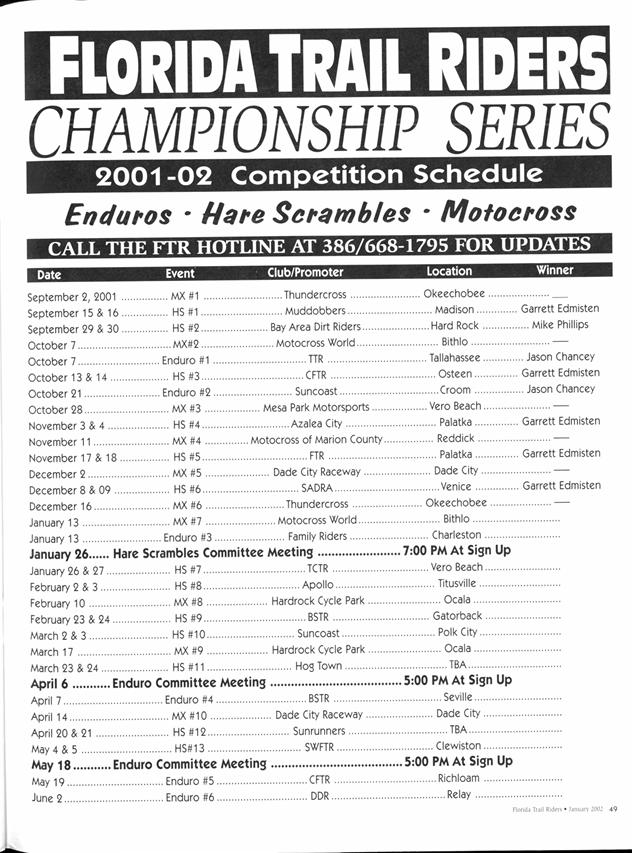




813-502-1228
sclark@mosaicfingroup.com
Just finished up the Bartow Harescramble. If I had to describe the race in one word, I would use the word – dusty. It was so frustrating trying to work up through the field when I could not see the ground. One thing I do in really dusty conditions is try to key off the rider in front of me. If I can’t see the ground, I try to follow in the exact same line as the rider in front of me and watch his body language. If he flinches, I know there must be a bump or a root that I will not be able to see. It is a little bit risky but most of the time it works out for me.
I think this is how some people plan for retirement. The path is really cloudy. They don’t know if it’s going to work out. They are not certain that they will have a successful retirement, but they go for it anyway. If this sounds like you, understand that it doesn’t have to be that way. By simply doing a little retirement planning, it can provide a clear path to and through retirement. This is how we help our clients by providing a retirement plan that is clear and easy to understand. If you think that might help you, give us a call to schedule a complimentary appointment.
Investment Advisory Services offered through Continuum Advisory, LLC, a Registered Investment Advisor, located at 873 E. State Street, Eagle, ID83616. Mosaic Financial Group is not an affiliate of Continuum Advisory, LLC but is a DBA (doing business as) of Continuum Advisory. For More information on Continuum Advisory, visit https://adviserinfo.sec.gov/firm/ summary/283155

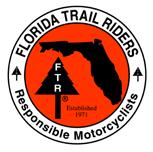

FLORIDA TRAIL RIDERS presents the 2024–2025 AMA FLORIDA HARE SCRAMBLE STATE CHAMPIONSHIP SERIES






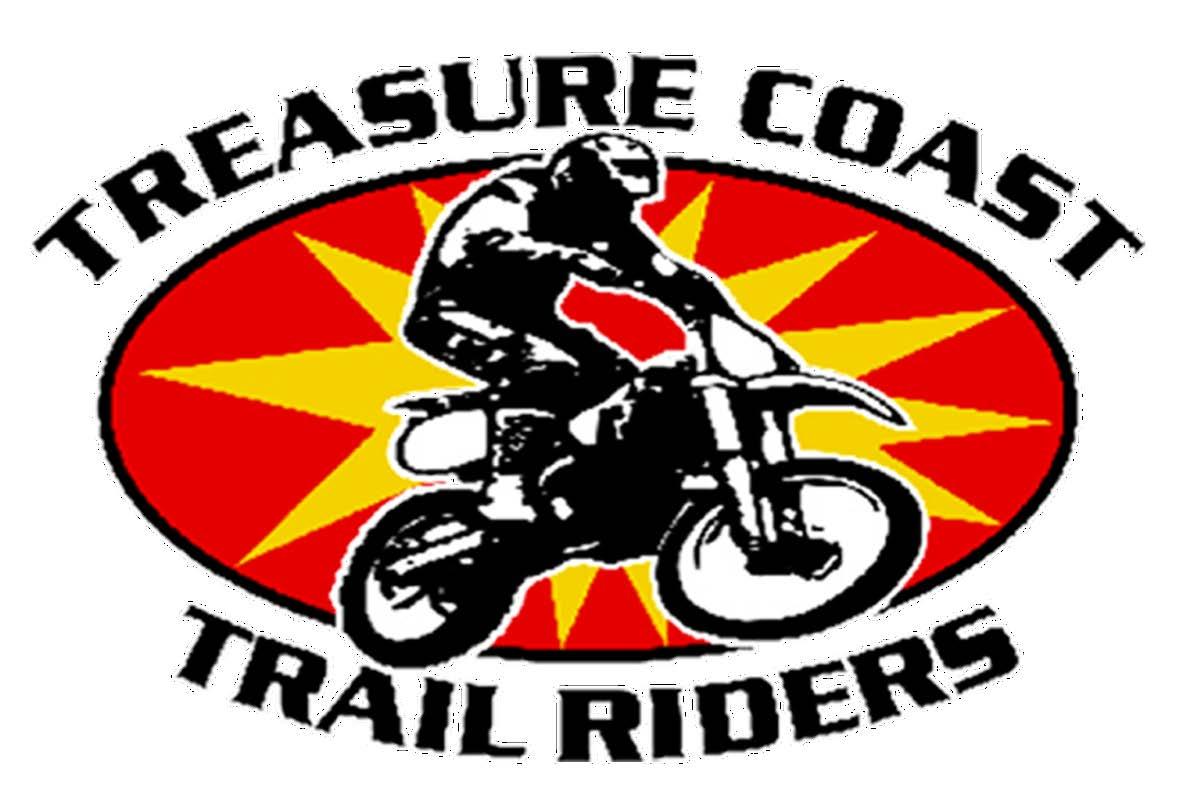
Presents the

For more information contact: Ken Harris (772) 370-4434
• ARMBANDS MUST BE WORN BY ALL PARTICIPANTS AND SPECTATORS AT ALL TIMES.
• NO GROUND FIRES.
• ALL DOGS MUST BE ON LEASHES.
• 96 db MAX sound limit.
• Tether switches required for all Quads.
• FTR transponders are required for scoring. They are available at signup.
• NO PIT RIDING
• Riders are responsible for correct colors. numbers. and letters — see Hare Scrambles Section of the FTR rulebook.
Riders and Guests are responsible for following all FTR rules.
Pre-entry: $20 PeeWee, $60 Bikes/Quads
Post-entry: $25 PeeWee, $65 Bikes/Quads
https://www.moto-tally.com/FTR/HS/PreEntry.aspx
SATURDAY
Signup 7:30a–10:30a
Peewee Track Practice:
8:30a-8:35a Peewee C / Beginner
8:40a–8:45a Peewee A / B 9:55a–10:05a Peewee: Clear Bikes
10:05a–10:10a Peewee Quad A / B 10:15a–10:20a Super Peewee Quad A / B
Peewee Races
Race 1 8:50a–9:05a Peewee Beginner
Race 2 9:10a–9:25a Peewee C
Race 3 9:30a–9:55a Peewee A / B Race 4 10:25a–10:45a Quad Peewee B
Race 5 10:50a–11:10a Quad Peewee A
Race 6 11:15a–11:40p Super Quad Peewee B
Race 7 11:45p–12:15p Super Quad Peewee A
Big Track Practice:
8:30a–9:00a Quad Practice
9:30a–10:00a Bike Practice
Mandatory Riders Meeting 11:30p
Race 8 11:45p–1:15p
Row 1 Mini A
Row 2 Mini B
Row 3 65A
Row 4 Mini C & Mini Girls
Row 5 65B
Row 6 65C, 65 Girls
Row 7 Mini Beginner 1
Row 8 Mini Beginner 2
Race 9 1:45p–3:15p
Row 1 Pre-Modern A
Row 2 Junior A
Row 3 Electric
Row 4 Junior B
Row 5 Pre-Modern B / C
Row 6 Pre-Modern SSR, Evo
Row 7 Junior C, Junior Girls
Row 8 Vintage, Evo Senior
Row 9 Women C
Row 10 Beginner
Sunday Race Signup 3:30–5:30p

1.2 West of Hwy 710 on SW Tommy Clements St
GPS Coordinates : 27°06'12.0"N 80°37'16.1"W
Gate Fee $30 - Good all weekend
Friday - 3:00 pm to Midnight Saturday - 6:00 am to Midnight Sunday - Opens at 6:00 am
Race 10 3:45p–5:15p Row 1 Quad AA
Row 2 Quad A
Row 3 Quad B Open
Row 4 Quad Plus 30 & Quad Veteran
Row 5 Quad Senior & Super Senior
Row 6 Quad Utility Open
Row 7 Quad Women & Quad Master
Row 8 Quad C Open Row 9 Quad Junior
Row 10 Quad
floridatrailriders.org:
THIS IS A RELEASE AND INDEMNITY AGREEMENT - READ IT BEFORE SIGNING
I HEREBY GIVE UP ALL MY RIGHTS TO SUE OR MAKE ANY CLAIM FOR DAMAGES DUE TO NEGLIGENCE OR ANY OTHER REASON WHATSOEVER AGAINST THE PROMOTERS, SPONSORS, AND ALL OTHER PERSONS, PARTICIPANTS OR ORGANIZATIONS CONDUCTING OR CONNECTED WITH THIS EVENT FOR INJURY TO PROPERTY OR PERSON I MAY SUFFER, INCLUDING CRIPPLING INJURY OR DEATH WHILE PARTICIPATING IN THE EVENT AND WHILE UPON EVENT PREMISES.
I KNOW THE RISKS OF DANGER TO MYSELF AND MY PROPERTY WHILE PREPARING FOR AND PARTICIPATING IN THE EVENT AND WHILE UPON THE EVENT PREMISES AND, RELYING UPON MY OWN JUDGMENT AND ABILITY, ASSUME ALL SUCH RISKS OF LOSS AND HEREBY AGREE TO REIMBURSE ALL COSTS TO THOSE PERSONS AND ORGANIZATIONS CONNECTED WITH THIS EVENT FOR DAMAGES INCURRED AS A RESULT OF MY NEGLIGENCE.
THIS IS A RELEASE
THIS IS A RELEASE


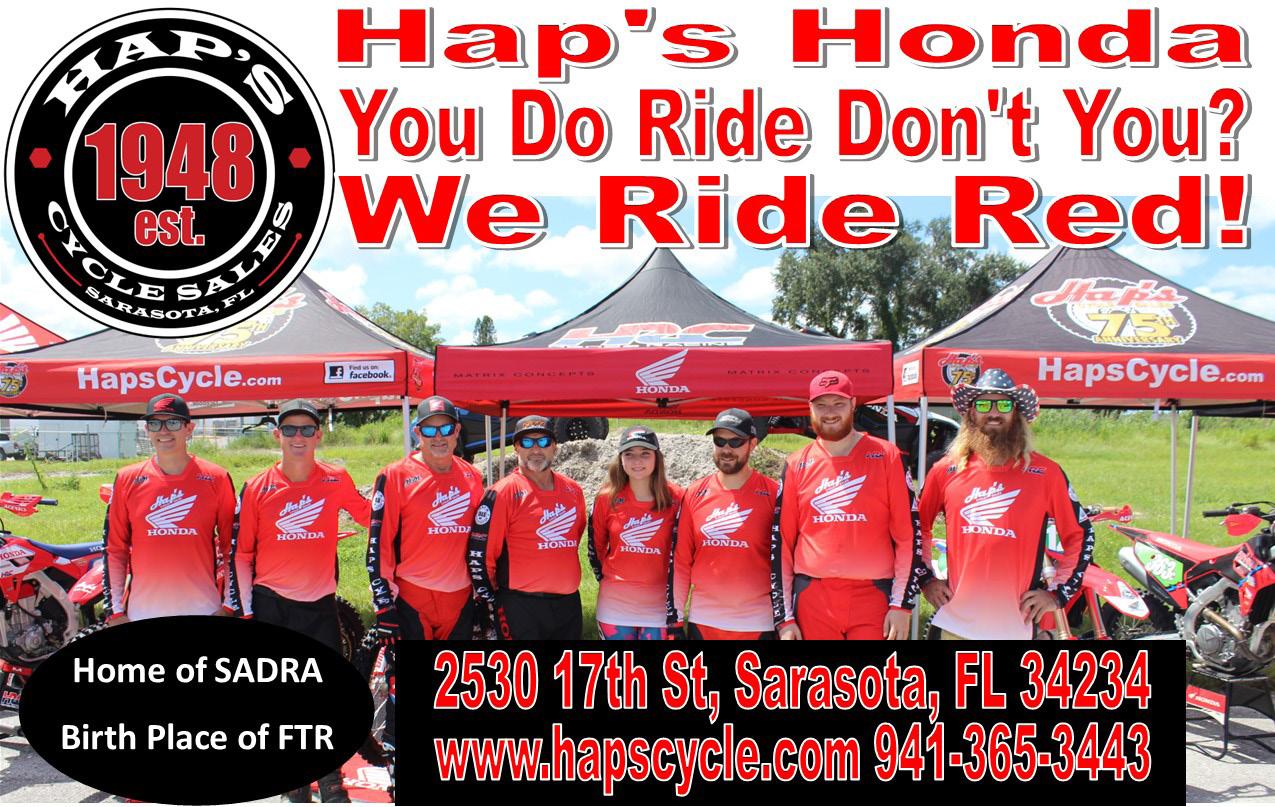




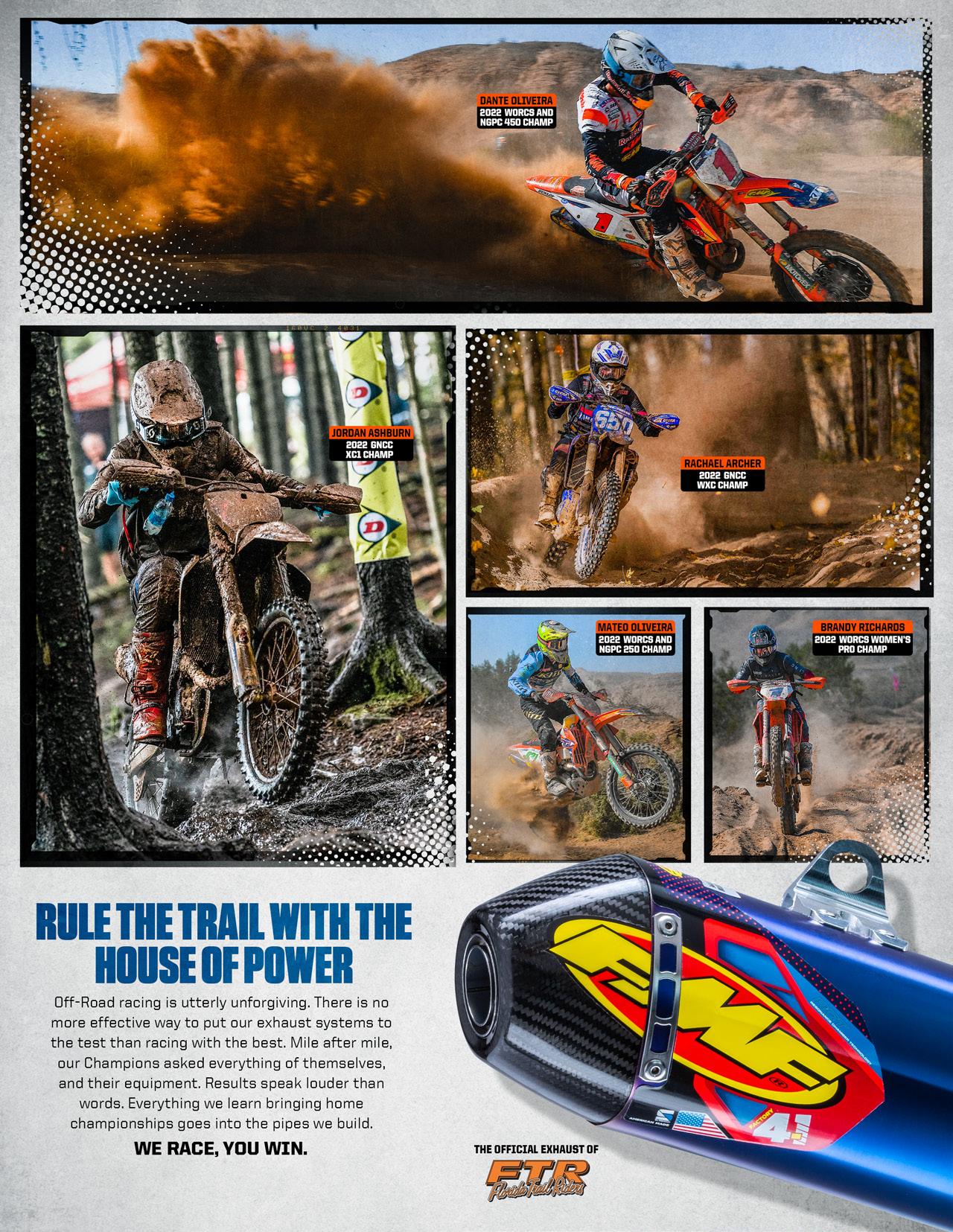



9-1-2024
